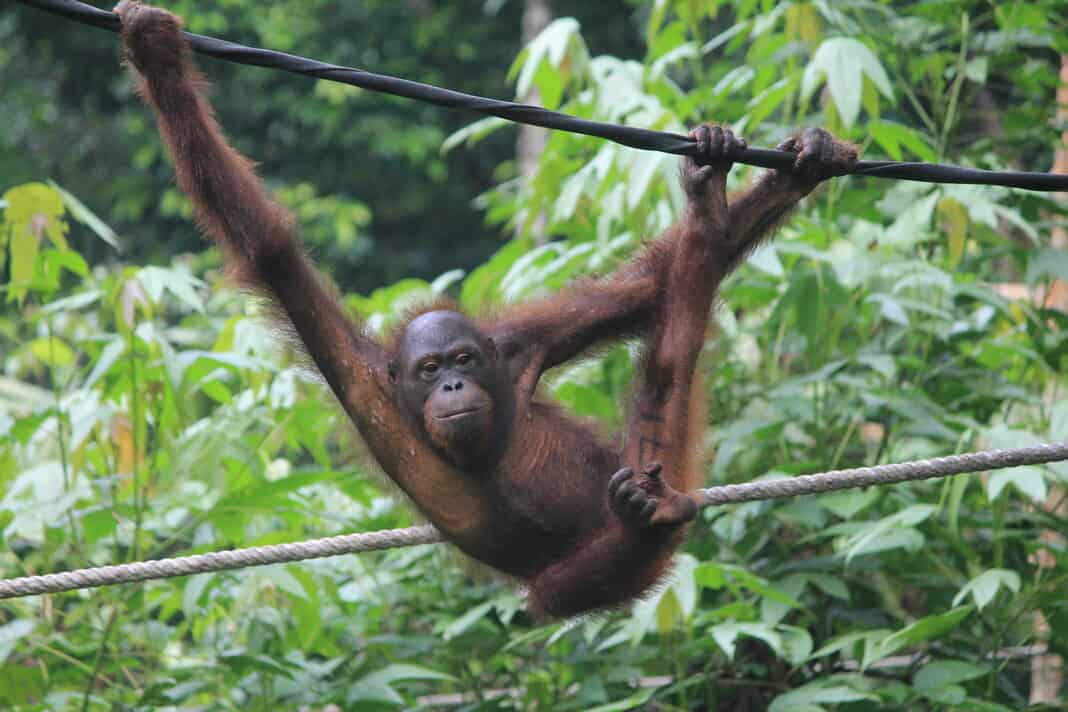If you’ve ever thought about cruising through the jungle in search of wild orangutans, then the Kinabatangan river cruise on Borneo Island in Malaysia is for you. One of the most diverse jungles on the planet, the Kinabatangan Wildlife Sanctuary is home to these beautiful creatures as well as hundreds of other species.
Most people haven’t even heard of Borneo Island. Split between Malaysia, Indonesia, and Brunei, it’s the third largest island in the world, covered almost entirely by dense rainforest. If you’re lucky, you just might see what remains of the world’s orangutan population in these pristine rainforests.
This post will focus on how to visit the Kinabatangan Wildlife Sanctuary, deep in the heart of the Malaysian rainforest, as a 2-day river safari from the Malaysian city of Sandakan. Here we will explain how to visit what remains of this native orangutan habitat and what to expect when you get there.
Note: this article contains affiliate links, which means that should you purchase something or get a quote through them I may make a small commission at no additional cost to you. This helps keep the site running with up to date information. I do not represent World Nomads, Booking.com, or GetYourGuide. This is information only and not a recommendation to buy the product mentioned in this article.
Kinabatangan River Cruise – What You Need to Know
Where is the Kinabatangan Wildlife Sanctuary?
The Kinabatangan Wildlife Sanctuary is just outside of Sandakan, Malaysia at the northeastern tip of the island of Borneo in southeast Asia. The closest major city as the crow flies is Manila, Philippines.
How to get there
Getting to the Kinabatangan Wildlife Sanctuary is not exactly easy, but going with an organized tour greatly simplifies the process. You will need to fly into Sandakan, where the Kinabatangan tours start, either from Kota Kinabalu or Kuala Lumpur. The domestic flight might be included in your tour, depending on who you book with and where you are coming from.
From Sandakan it’s about a two-hour drive to the Kinabatangan River, where you will get on a boat that will take you to wherever you are staying along the river in the sanctuary. Transportation will be arranged by the tour company who will pick you up from the airport in Sandakan.
Organized Kinabatangan River Cruise tours
While it is possible to visit the Kinabatangan Wildlife Sanctuary on your own, it’s quite difficult and honestly not worth the hassle. The lodges along the river offer accommodation as part of an overnight tour package. It’s sort of like an all-inclusive stay, which includes pickup in Sandakan (usually from the airport), a room, food, and various tours with a licensed tour guide.
Very few accommodations offer options for just a room. And if you go that route, you’ll have to get yourself from Sandakan to the river then hire a boat to take you to your lodge, so you’ll have to figure your own way down the river in a dense jungle. Not recommended!.
You could also book a room in the small village along the river at the end of the road and arrange boat rides down the river on your own. However, the rates that many of the lodges offer for their tour services are very affordable and definitely worth it to get the best experience so I highly recommend doing it that way.
When you spend the night in the jungle at a lodge that comes with a tour – which we highly recommend – your accommodation will take care of everything for you. In fact it’s part of booking your room. When you book you’ll have to choose which package you want.
It’s not possible to book just a room only at most places. It comes with at least one cruise down the river and a pickup in Sandakan. Typical options are a 1-day 1-night tour, a 2-day 1-night tour, and a 3-day 2-night tour. With the 1-day 1 -night tour you will do one cruise down the river in the afternoon, stay the night, and then be taken back to Sandakan in the morning.
The 2-day 2-night is similar, but you get a morning cruise and some additional destinations in the jungle. And the 3-day 2-night is just an extension of that.
Where to stay
There are quite a few different lodges in the rainforest along the river that all offer a similar experience, as previously discussed. Booking the lodges is easy, and you choose which tour package you want while booking. You can book directly through the lodge or on Booking.com.
We stayed at the Borneo Nature Lodge and highly recommend it. The lodge was beautiful and the food was delicious. Our tour guide was great and super friendly. You definitely can’t go wrong with the Borneo Nature Lodge!
Best Lodges in Kinabatangan
Borneo Nature Lodge (Booking.com link)
Bilit Rainforest Lodge (Booking.com link)
If you’re looking for a place to book that is room-only, you can have a look at the Borneo Jungle Adventure lodge. You’re on your own for getting into the jungle there though, so be warned!
Weather and when to go
Borneo straddles the Equator so the days are pretty much the same all year round, though the winter months (Dec-March) see heavier and more frequent rainfall. It’s always hot and humid in the rainforest. Prepare for rain at any time and make use of cold showers to cool down.
Your best bet to keep dry and see orangutans is between June and September. That being said, I went in December and it didn’t rain at all. I also got a sighting of a wild orangutan with a little baby. They are more frequently seen in the (northern hemisphere) summer months, so that’s really the best time to go to Kinabatangan.
Money
The currency in Malaysia is the Malaysian Ringgit. You will need cash to tip your guide and if you want to purchase anything from the shops at the end of the road or in the city of Sandakan. All food and lodging in the rainforest will be included in the nightly rate you are paying (unless you’re doing the room-only option as discussed above).
Language
The local language in Malaysia is Malay. Your guide will speak English, as well as the workers at the lodges. But most other people you encounter around this part of Malaysia will not. If you don’t speak any English or Malay, you’ll struggle in this part of the world.
Animals you might see in the Kinabatangan Wildlife Sanctuary
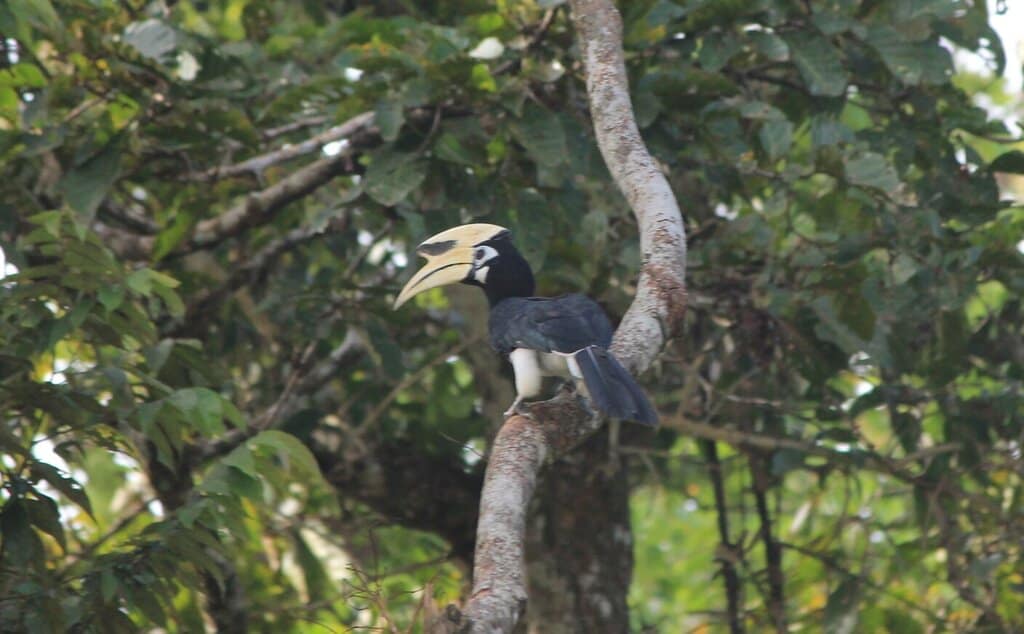
While the highlight of this part of the world is orangutans, there is an abundance of other wildlife as well. In this region you will also find proboscis monkeys, macaque monkeys, red leaf monkeys, crocodiles, monitor lizards, pygmy elephants (aka Bornean elephants), as well as many other smaller jungle creatures and hundreds of bird species.
Food
The food offered in the rainforest lodges is remarkably delicious. Malaysian food is like a fusion of Indian and east Asian, but the thing I found most interesting is that they eat warm noodles with eggs for breakfast. It’s actually a pretty great combination.
Malaysians also seem to love KFC, as the Colonel is everywhere in Malaysian cities. Luckily your rain forest tour won’t be spoiled by unwanted American fast food restaurants once you’re outside Sandakan.
Travel Insurance
When visiting the rainforest it’s a good idea to have travel insurance. We use World Nomads and had a good experience the one time we unfortunately had to actually use it. World Nomads provides coverage to travelers in over 100 countries. You can search for a coverage plan using the link below.
A Quick Background on Orangutans
Orangutans are our closest living ancestors, sharing nearly 95% of human DNA. Known for their orange fur and freakishly long arms, they are the only species of great apes who live in the trees. They sleep in nests, like birds, and live solitary lives, unlike the other great apes who hang out in groups.
While once plentiful in the wild, orangutans are currently an endangered species. It is estimated that there are only about 100,000 Borneo Orangutans left on the island. The reasons for their endangerment vary. Females only give birth every 3-5 years and like humans usually have just one baby at a time.
They can be victims of poaching too. But the main reason for their plight is clearly evident when you go on a tour through the Malaysian rainforest: habitat loss and deforestation. The sheer number of palm oil farms you see on the way from Sandakan to the sanctuary is staggering. Rainforest is torn away every day to make room for palm oil farms. And every tree cut down is one less home for the orangutans.
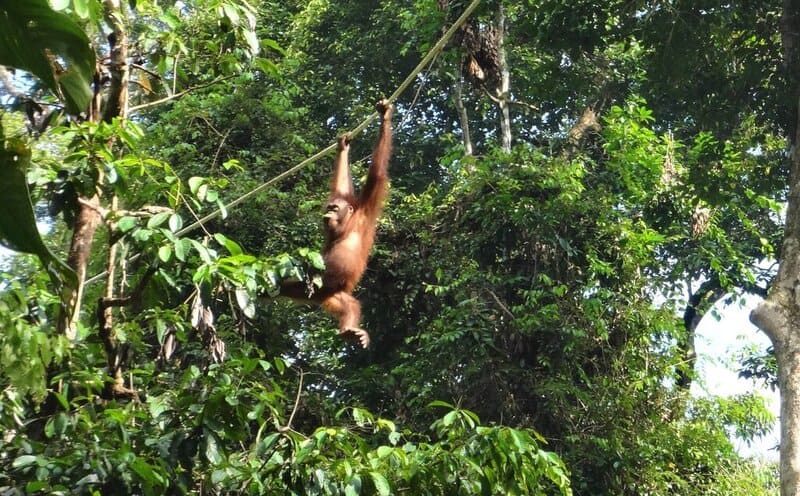
I didn’t know anything about palm oil before this trip, but I quickly learned that it is in almost everything. And not just food. Palm oil is used in shampoo and lipstick and tons of other cosmetic products. While it’s not sold as a cooking oil, it’s put into a wide range of processed food such as instant noodles or cereals.
There isn’t much you can do to avoid palm oil without going full organic. I don’t mention this to make you feel bad that washing your hair and eating breakfast is killing orangutans, but just to make you aware of the situation.
The Kinabatangan River Cruise and Tour
We did a 2-day 1-night rainforest tour with Borneo Nature Lodge and found it an adequate amount of time to see the highlights of the Malaysian jungle. Your adventure will start when you arrive in Sandakan and are picked up at the airport by your guide and driver. There are various stops included in your tour and we will go through all of those here.
Sepilok Orangutan Rehabilitation Centre
The first stop in most tours from Sandakan will be the Sepilok Orangutan Rehabilitation Centre. The sanctuary was set up by a British woman in 1964 and now is the most important orangutan rehabilitation center in the world.
The goal of Sepilok is to nurse injured orangutans back to health and slowly prepare them for life in the wild. It takes a few years for the process to complete but eventually, if the orangutan is deemed fit, it will be released into the wild.
Technically there are no fences for the sanctuary. The animals can leave whenever they want. But why would they leave when they get fed delicious fruit twice a day? Sepilok is your only guaranteed orangutan spotting on your tour, so long as you are there at feeding time. The Centre is in the dense jungle, but these guys aren’t going to skip breakfast.
Getting to the Kinabatangan River
After the Rehabilitation Centre you will hit the road towards the Kinabatangan River. It won’t be long before you see your first palm oil farm. While full of palm trees, these farms look completely different than the natural rainforest as their trees are perfectly aligned and evenly spaced apart.
There is a small village at the foot of the river and this will be your last place to get snacks, drinks, cash, etc,so make use of it if you need something. You’ll bid farewell to your driver here and get picked up by a boat that will take you down the river into the sanctuary.

Lodges along the Kinabatangan River
Most of the rainforest lodges are in the same area, near the village of Bilit, 20-25 minutes down the river from the road. You’ll likely get to your lodge in time for lunch.
Here along the river you are deep in the heart of the Malaysian rainforest. Nature rules here, and as a visitor it is your duty to leave this pristine environment intact. Do not litter and respect the locals when they tell you to do something.
If you’re worried that spending the night in the jungle means you will be roughing it, fear not. Our room had a new air conditioning unit and the entire lodge was very nicely done. The food was excellent – all buffet style – and the service was top notch. I was pleasantly surprised with how comfortable the lodge was for its remote location.
Cruise the Kinabatangan River in search of orangutans
While your lodge will surely be nice, you didn’t come all this way to sit in an air conditioned room and check your Instagram feed. In the afternoon you will be whisked away for a long, relaxing ride down the river.
This is the main draw of the entire tour and what you came to Malaysia for. The monkeys and other animals usually hang out around the river, so this is your best bet to see wildlife.
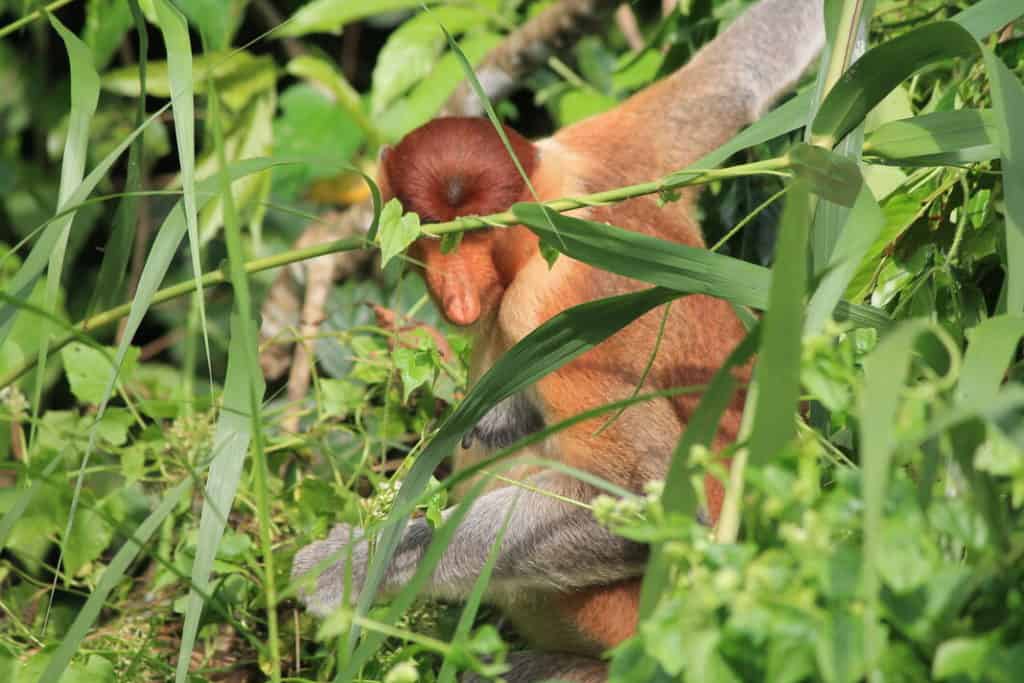
The first monkeys we saw were proboscis monkeys, a funny looking larger monkey with a huge nose. The males constantly have erections. I’m not kidding at all. Although they hide under the bushes pretty well, so I never actually saw one of them below the waist. The proboscis monkey is indigenous to Borneo, so you won’t see these guys or their genitalia anywhere else in the world.
The most common creature you will see is the macaque monkey, a smaller grey monkey that seems to spend its entire day cleaning itself. Macaques are found all over the world and you will surely see many on your trip down the river.

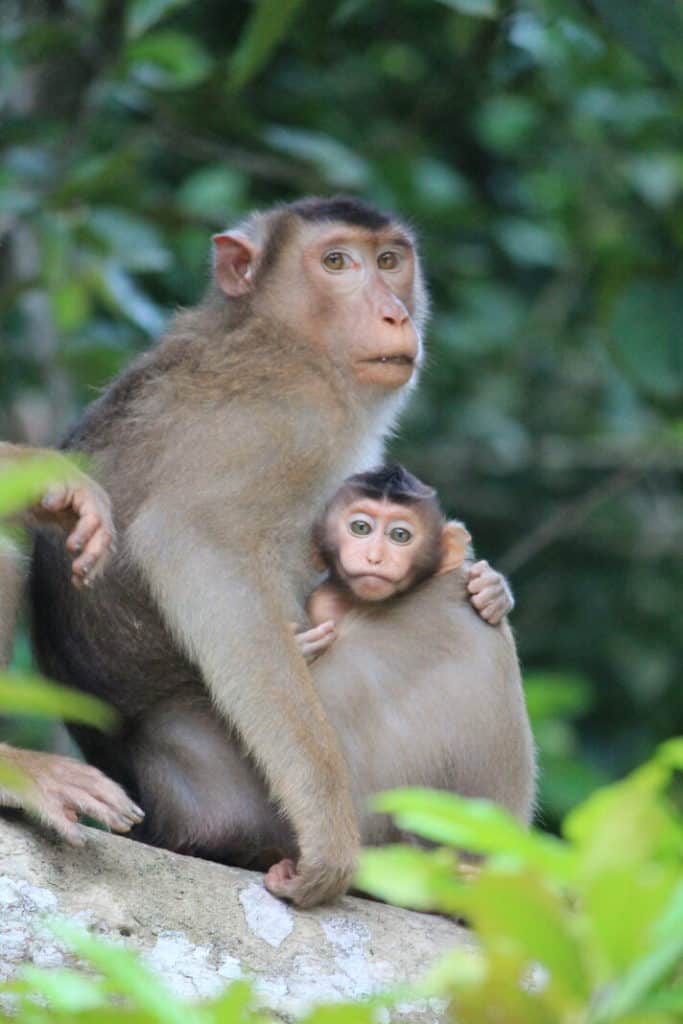
Not everyone gets to see an orangutan along the river, but that’s the ultimate goal. Keep your eyes peeled and constantly be scanning the trees. Orangutans spend most of their days lounging around, so they’re not just going to announce to you that they are there.
If you’re doing the two-day tour, you will get one more chance to cruise the river early the next morning. Do not waste any opportunity to ride down the Kinabatangan River in search of orangutans. This is what you came all this way for!
Gamontong Caves
The Kinabatangan River cruise tour will also stop at Gomantong Caves on the second day. A huge cave in the hills, this is one of the prime locations in the world to harvest edible bird nests. This might sound gross, but bird nest soup is a delicacy in China.
Harvesters live in and around the cave and collect the bird nests for export. On top of this, the cave is usually full of bats, whose droppings form large mounds of poo at the base of the cave. Not surprisingly, the cave is known to smell pretty bad.
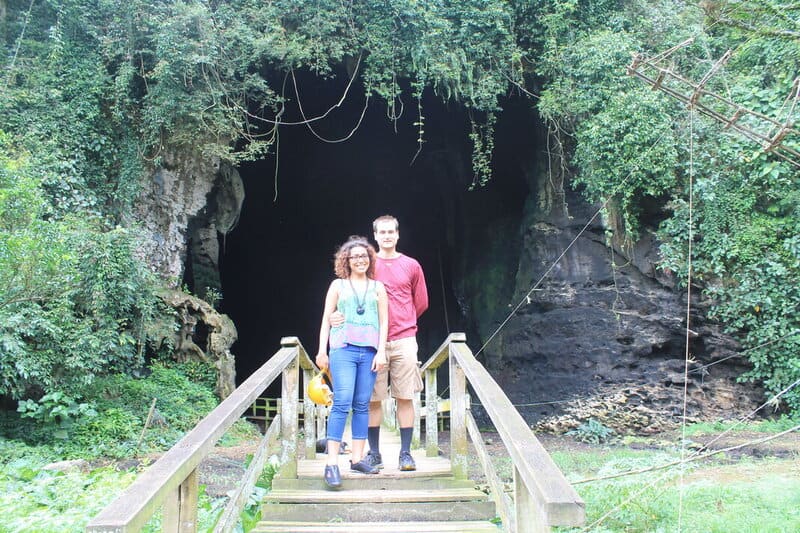
Right as we were about to enter the cave, another tour guide whispered something to our guide in Malay. “Up there,” our guide says. We look up to see a mother orangutan and her baby right above us in the tree. These two orangutans were very chilled out, just sitting up in the tree, relaxing. The baby took a few opportunities to swing on some branches and test his little arms out. It was very special to see an endangered species like this in the wild!
There wasn’t too much to do inside the cave itself other than wonder why someone would ever eat this stuff. You can walk around and try not to get pooped on by the birds and bats. You will actually be required to wear a hardhat inside the cave in case something falls on your head.
Inside the cave there are tiny wooden shacks with nothing but a bed. In peak harvesting season, the harvesters will work day and night only stopping to sleep in these shacks. No thanks.

Sandakan city
The last part of the 2-day tour will be a city tour of Sandakan. There are few interesting things in Sandakan, like the floating Sim Sim Water Village. and various Buddhist temples, Christian churches, and Muslim mosques. But nothing quite compared to wild orangutans.
The thing I found the most interesting about Sandakan was the mixture of three large religions: Christianity, Islam, and Buddhism. Churches, mosques, and temples are everywhere. It’s quite fascinating.
A discussion of what to do in Sandakan is beyond the scope of this post. If you are interested to know more about Sandakan I suggest maybe starting here. Your guide will also be very knowledgeable and able to answer any questions you might have.
Other Bornean Rainforest Options
Kinabatangan Wildlife Sanctuary is not the only place to see orangutans in the wild. This part of Malaysia features a few other protected areas that have similar tours and wildlife viewing opportunities. There are so many more off the beaten path destinations in Borneo that it can be hard to keep track.
Here is a list of some of the other natural areas you can consider visiting if what I’ve described about the Kinabatangan Wildlife Sanctuary doesn’t float your boat:
- Danum Valley Conservation Area
- Tabin Wildlife Resort
- Kulamba Wildlife Reserve
It’s also possible to visit some of the highlights of the jungle in Borneo as a day trip from Sandakan. These tours will take you to the Sepilok Orangutan Rehabilitation Centre, as well as a sanctuary for proboscis monkeys and the Bornean Sun Bear Conservation Centre.
It will be a busy day, but you’re guaranteed to see monkeys and bears, just not totally in the wild. You can check out some options on Viator below.
Managing Expectations
I want to make it clear that you absolutely should NOT go on a Kinabatangan River cruise into the Malaysian rainforest expecting to see wild orangutans. They are an endangered species and the island of Borneo is huge. Their concentration on the island is about one orangutan every three square miles.
Of course the concentration is considerably higher in the Kinabatangan Wildlife Sanctuary, but they are still spread out and high in the trees of the jungle. They are solitary creatures and can be very difficult to spot if they are not moving around. You will see orangutans at the Rehabilitation Centre, but they are not really wild.
You should also have no expectations to see a pygmy elephant. While plenty of people see them bathing in the river, there are fewer than 2,000 of these elephants left in the wild these days. While their highest concentration is in the region of Kinabatangan, they are still tough to come by (I did not see any).
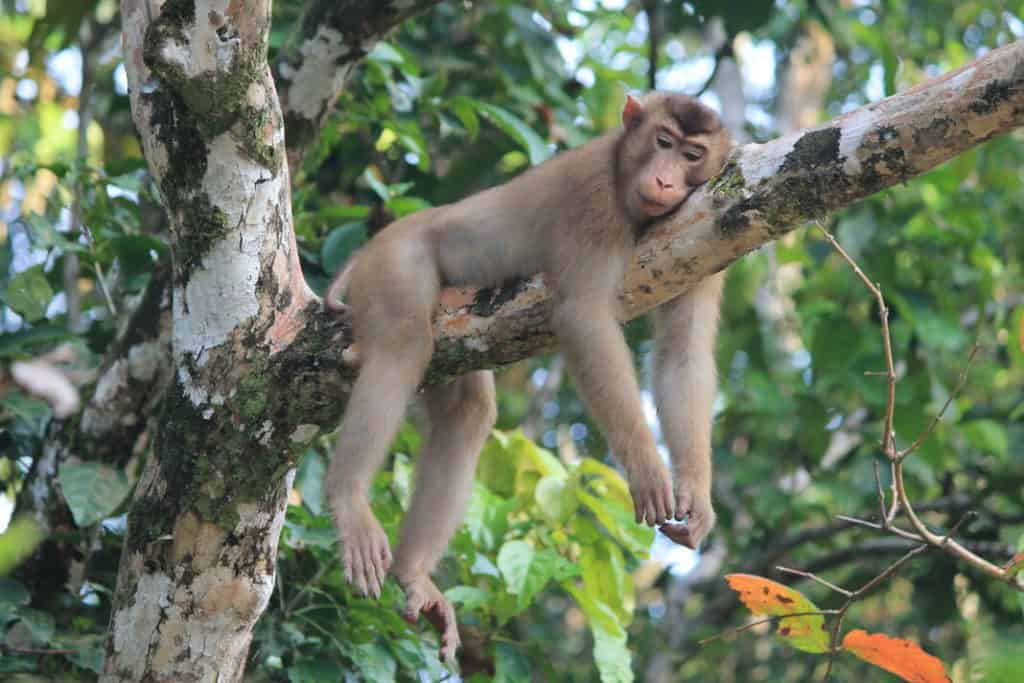
What you can be almost guaranteed to see are macaque monkeys. They are literally everywhere along the river. You can also have reasonable expectations to see some proboscis monkeys. They aren’t as plentiful as the macaques, but there are a lot of them in this region. Regardless, you can expect to be fascinated with the nature and wildlife of this part of the world no matter what you see.
Frequently Asked Questions
What animals are on the Kinabatangan River cruise?
The Kinabatangan River is home to some amazing animal species. Along the river you can find orangutans, proboscis monkeys, macaque monkeys, red leaf monkeys, crocodiles, monitor lizards, pygmy elephants, and hundreds of bird species.
When should I visit the Kinabatangan River?
The best time to visit the Kinabatangan River is in the summer between June and September. This is the driest time of the year and when orangutans are most likely to be out.
Is Kinabatangan safe?
The Kinabatangan Wildlife Sanctuary is known to be a safe place to travel so long as you respect the wildlife and don’t go wandering through the jungle alone at night. There are no dangerous indigenous tribes (like you find in the Amazon) and crime is not common.
Are there crocodiles at the Kinabatangan River?
Yes, there are crocodiles along the Kinabatangan River. They are not exactly common to see, but you don’t really want to go out for a swim in the muddy river.
Final Word
A trip to the Kinabatangan Wildlife Sanctuary in the heart of the Borean rainforest in Malaysia is an unforgettable experience. It’s not exactly easy to get to, but you will leave this magnificent island wanting more.
There are so many fascinating animal species that only live on Borneo. And if you’re lucky, you might even get to see an orangutan or two in their natural habitat!

